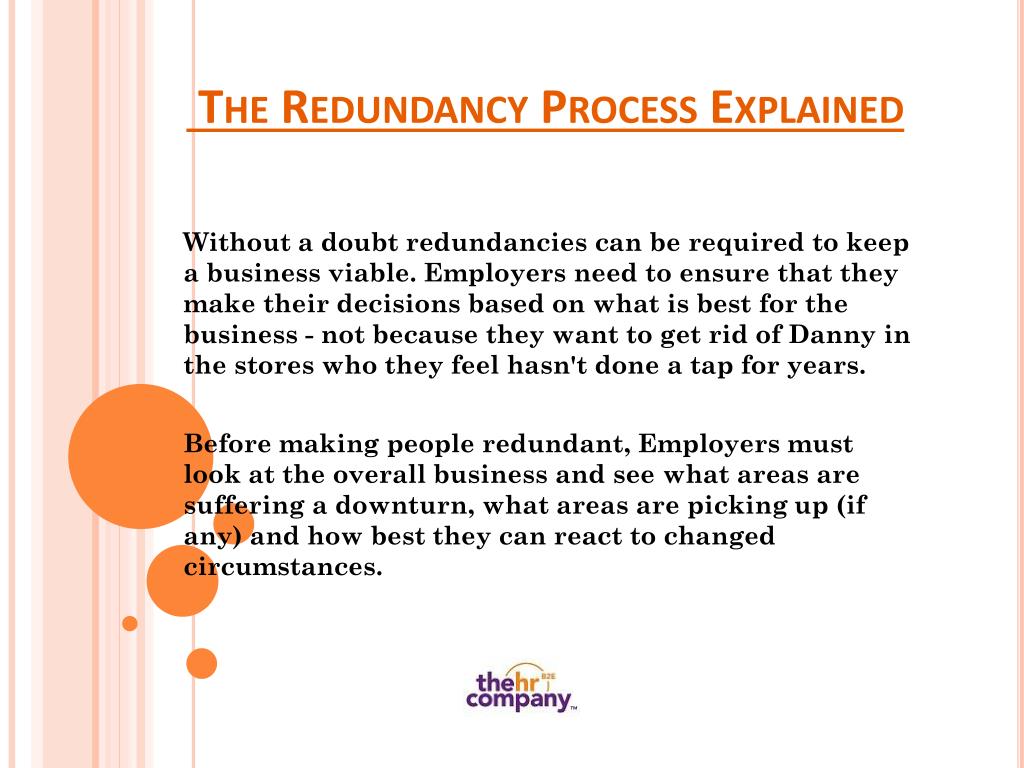What Happens to Redundancy If Company Goes Bust? An Overview to Your Rights
What Happens to Redundancy If Company Goes Bust? An Overview to Your Rights
Blog Article
Discovering the Operational Characteristics of Firm Redundancy and Its Long-Term Sustainability

Redundancy Methods for Service Connection
In order to ensure continuous procedures, companies need to apply efficient redundancy strategies for company continuity. Redundancy in this context describes the replication of crucial parts or features within a system to minimize the impact of prospective failings. By integrating redundancy strategies, companies can improve their durability versus interruptions brought on by various variables such as all-natural calamities, devices failings, or cyber-attacks.
One common redundancy method is the application of back-up systems and information storage solutions. This includes developing duplicates of necessary data and systems that can be triggered in instance of a key system failing. Furthermore, organizations can develop redundant communication channels and source of power to preserve connection and procedures during unforeseen occasions.
Moreover, cross-training workers to carry out numerous roles within the business can serve as a beneficial redundancy technique. If key employees are inaccessible due to health problem or other reasons, this makes sure that essential jobs can still be brought out also. In general, reliable redundancy strategies are essential for companies to support functional connection and reduce the effect of possible disturbances.
Influence of Redundancy on Organizational Strength
Given the crucial duty redundancy approaches play in guaranteeing organization continuity, exploring the influence of redundancy on organizational durability comes to be critical for understanding the all natural functional characteristics of a company. Redundancy, when tactically executed, can substantially add to enhancing a company's strength in the face of unexpected challenges.
Furthermore, redundancy can bolster staff member morale and self-confidence, knowing that there are backup plans in area to attend to unforeseen situations. This sense of protection can cause increased productivity and a more favorable workplace. In addition, redundancy can promote advancement and creativity within a company as workers feel empowered to take computed dangers, knowing that there is a safeguard to sustain them in instance of failing. In general, the influence of redundancy on organizational strength is profound, shaping the lasting sustainability and success of a company.
Stabilizing Efficiency and Flexibility in Redundancy
Achieving a harmonious stability in between functional effectiveness and adaptive flexibility is a critical challenge in the calculated deployment of redundancy within companies. Also much flexibility without a strong operational foundation can result in inadequacies and inconsistency.
To balance effectiveness and adaptability in redundancy planning, companies have to thoroughly assess their operational demands, market characteristics, and tactical objectives. Implementing lean methods can boost efficiency by getting rid of and improving procedures waste, while promoting a society of adaptability and constant renovation check can boost flexibility. Additionally, buying cross-training programs and robust communication networks can assist cultivate a flexible labor force efficient in taking care of diverse tasks during periods of change. Eventually, finding the best stability between performance and versatility is vital for building a lasting and durable company when faced with uncertainty.
Long-Term Sustainability Via Redundancy Preparation
To make certain enduring viability and security, organizations have to strategically straighten their redundancy planning with long-lasting sustainability objectives, consequently harmonizing functional effectiveness with flexible adaptability. Business should view redundancy not as a responsive option to immediate issues but as a positive method for long-term success.

Positive Measures for Lasting Firm Workflow
How can business proactively improve their functional sustainability for lasting success? Applying aggressive actions is crucial for business aiming to make sure lasting procedures.
Moreover, promoting a culture of constant enhancement and discovering within the company can improve adaptability to changing market conditions and client needs. Urging worker participation in decision-making procedures and giving opportunities for expert advancement can enhance morale, productivity, and general efficiency. Developing clear goals, keeping an eye on key efficiency indications, and regularly examining progression are essential components of aggressive sustainability administration.
Collaborating with providers, consumers, and other stakeholders to advertise lasting techniques throughout the supply chain can create a causal sequence of positive influence - redundancy pay if company goes bust. By taking proactive steps towards operational sustainability, firms can construct resilience, drive technology, and secure their lasting success in an ever-evolving business landscape
Conclusion

In the realm of organizational management, the critical release of company redundancy stands as a critical yet intricate practice that demands a delicate equilibrium between functional efficiency and long-lasting practicality. By studying the functional characteristics that underpin company redundancy and assessing its wider implications for business strength and versatility, a nuanced understanding of just how redundancy methods can form the future trajectory of a firm begins to unfold.Given the vital duty redundancy methods play in making certain service connection, exploring the impact of redundancy on business durability ends up being critical for recognizing the holistic functional dynamics of a company. Generally, the influence of redundancy on organizational durability is profound, forming the long-lasting sustainability and success of a business.
In final thought, recognizing the operational characteristics of company redundancy is crucial for making sure long-term sustainability.
Report this page